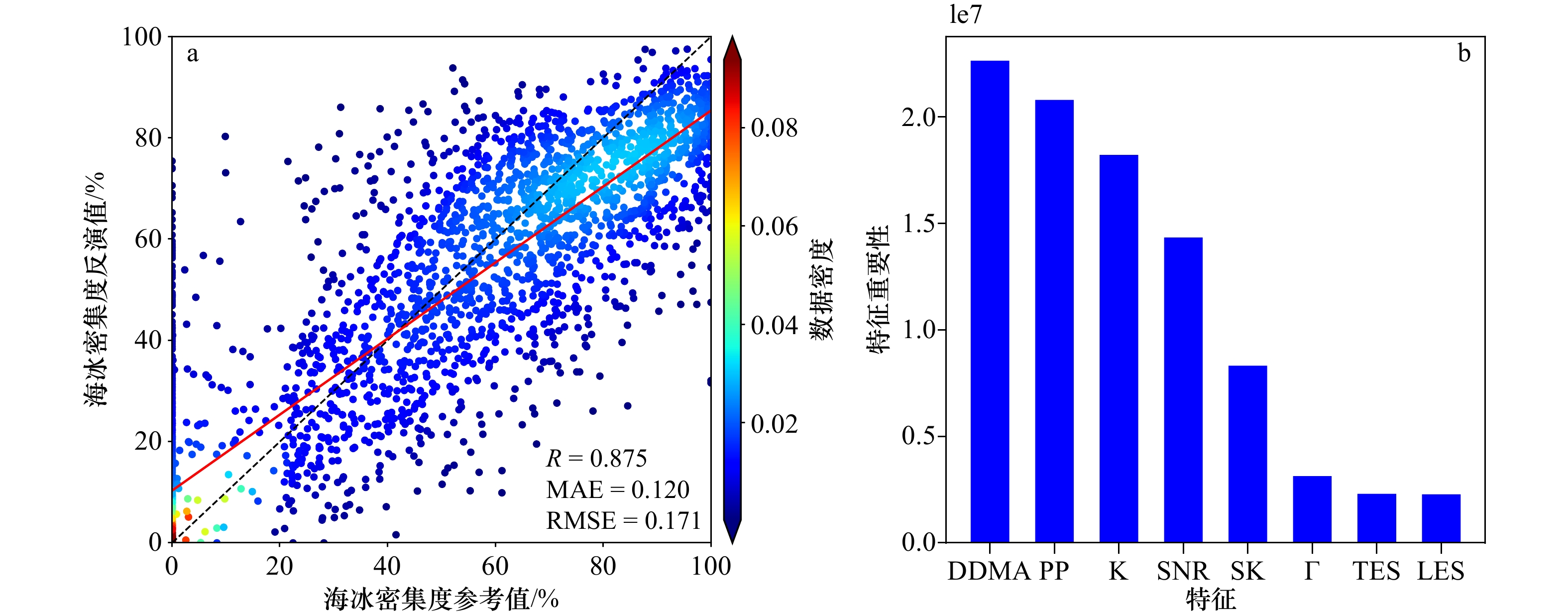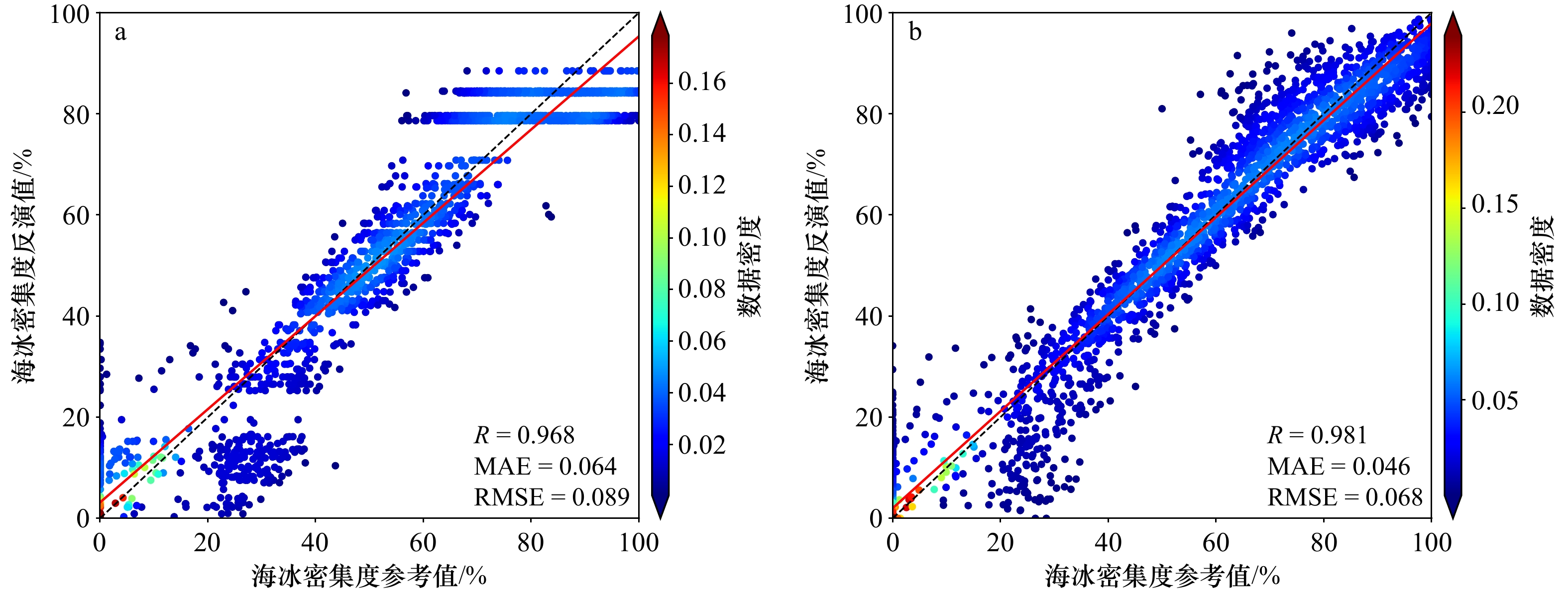Sea ice concentration retrieval using spaceborne GNSS-R during the melting period
-
摘要: 针对北极融冰期的海冰密集度反演,并改善全球导航卫星系统反射测量(GNSS-R)对海水的海冰密集度高估问题,本文提出一种利用机器学习算法生成高时空分辨率的融冰期海冰密集度估算方法,提取GNSS-R时延多普勒图(DDM)的特征参数,并结合海表温度数据建立LightGBM模型,将反演结果与参考海冰密集度值进行相关性分析和评估。本文的模型结果与OSI SAF的海冰密集度产品显示出较好的一致性,相关系数、平均绝对误差和均方根误差分别为0.965、0.061和0.090,该方法能够实现对北极海冰边缘区的海冰密集度高精度估计。Abstract: In this paper, a high spatial-temporal resolution sea ice concentration estimation method for the Arctic melting season is proposed, aiming to improve the overestimation of sea ice concentration in seawater by the Global Navigation Satellite System-Reflectometry (GNSS-R). The method utilizes machine learning algorithms to extract feature parameters from the Delay Doppler Maps (DDM) obtained through GNSS-R and combines them with sea surface temperature data to establish a LightGBM model. The inversion results are then subjected to correlation analysis and evaluation against reference sea ice concentration values. The model's performance is compared with the sea ice concentration product from OSI SAF, demonstrating good consistency, with correlation coefficient, mean absolute error, and root mean square error being 0.965, 0.061, and 0.090, respectively. This approach enables high-precision estimation of sea ice concentration in the Arctic marginal ice zone.
-
Key words:
- GNSS-R /
- DDM /
- melting season /
- sea ice concentration /
- LightGBM /
- Arctic
-
表 1 不同特征参数组合的反演误差统计表
Tab. 1 Error Statistics for Different DDM observables Combinations
序号 特征参数组合 R MAE RMSE 1 DDMA + SNR + PP + TES + LES + K + SK (无Γ) 0.867 0.124 0.176 2 Γ + SNR + PP + TES + LES + K + SK (无DDMA) 0.859 0.128 0.181 3 Γ + DDMA + PP + TES + LES + K + SK (无SNR) 0.817 0.146 0.204 4 Γ + DDMA + SNR + TES + LES + K + SK (无PP) 0.851 0.132 0.186 5 Γ + DDMA + SNR + PP + LES + K + SK (无TES) 0.871 0.122 0.174 6 Γ + DDMA + SNR + PP + TES + K + SK (无LES) 0.871 0.122 0.174 7 Γ + DDMA + SNR + PP + TES + LES + SK (无K) 0.866 0.124 0.177 8 Γ + DDMA + SNR + PP + TES + LES + K (无SK) 0.866 0.125 0.177 9 Γ + DDMA + SNR + PP + TES + LES + K + SK 0.875 0.120 0.171 -
[1] Li Xiaoming, Sun Yan, Zhang Qiang. Extraction of sea ice cover by sentinel-1 SAR based on support vector machine with unsupervised generation of training datas[J]. IEEE Transactions on Geoscience and Remote Sensing, 2021, 59(4): 3040−3053. doi: 10.1109/TGRS.2020.3007789 [2] Chen Jinlei, Kang Shichang, You Qinglong, et al. Projected changes in sea ice and the navigability of the Arctic Passages under global warming of 2 ℃ and 3 ℃[J]. Anthropocene, 2022, 40: 100349. doi: 10.1016/j.ancene.2022.100349 [3] 谢涛, 赵立. 海冰密集度卫星遥感反演研究进展[J]. 海洋科学进展, 2022, 40(3): 351−366. doi: 10.12362/j.issn.1671-6647.20220209001Xie Tao, Zhao Li. Advances in sea ice concentration retrieval based on satellite remote sensing[J]. Advances in Marine Science, 2022, 40(3): 351−366. doi: 10.12362/j.issn.1671-6647.20220209001 [4] Zavorotny V U, Gleason S, Cardellach E, et al. Tutorial on remote sensing using GNSS bistatic radar of opportunity[J]. IEEE Geoscience and Remote Sensing Magazine, 2014, 2(4): 8−45. doi: 10.1109/MGRS.2014.2374220 [5] Yan Qingyun, Huang Weimin, Moloney C. Neural networks based sea ice detection and concentration retrieval from GNSS-R delay-Doppler maps[J]. IEEE Journal of Selected Topics in Applied Earth Observations and Remote Sensing, 2017, 10(8): 3789−3798. doi: 10.1109/JSTARS.2017.2689009 [6] Yan Qingyun, Huang Weimin. Sea ice sensing from GNSS-R data using convolutional neural networks[J]. IEEE Geoscience and Remote Sensing Letters, 2018, 15(10): 1510−1514. doi: 10.1109/LGRS.2018.2852143 [7] Yan Qingyun, Huang Weimin. Sea ice concentration estimation from TechDemoSat-1 data using support vector regression[C]//2019 IEEE Radar Conference (RadarConf). Boston: IEEE, 2019: 1-6. [8] Llaveria D, Munoz-Martin J F, Herbert C, et al. Sea ice concentration and sea ice extent mapping with l-band microwave radiometry and GNSS-R data from the FFSCat mission using neural networks[J]. Remote Sensing, 2021, 13(6): 1139. doi: 10.3390/rs13061139 [9] Zhu Yongchao, Tao T, Zou J, et al. Spaceborne GNSS reflectometry for retrieving sea ice concentration using TDS-1 data[J]. IEEE Geoscience and Remote Sensing Letters, 2021, 18(4): 612−616. doi: 10.1109/LGRS.2020.2982959 [10] Guo Wenfei, Du Hao, Guo Chi, et al. Information fusion for GNSS-R wind speed retrieval using statistically modified convolutional neural network[J]. Remote Sensing of Environment, 2022, 272: 112934. doi: 10.1016/j.rse.2022.112934 [11] Liu Hongsu, Jin Shuanggen, Yan Qingyun. Evaluation of the ocean surface wind speed change following the super typhoon from space-borne GNSS-reflectometry[J]. Remote Sensing, 2020, 12(12): 2034. doi: 10.3390/rs12122034 [12] Yan Qingyun, Huang Weimin. Spaceborne GNSS-R sea ice detection using delay-Doppler maps: first results from the U. K. TechDemoSat-1 mission[J]. IEEE Journal of Selected Topics in Applied Earth Observations and Remote Sensing, 2016, 9(10): 4795−4801. doi: 10.1109/JSTARS.2016.2582690 [13] Cartwright J, Banks C J, Srokosz M. Sea ice detection using GNSS-R data from TechDemoSat-1[J]. Journal of Geophysical Research: Oceans, 2019, 124(8): 5801−5810. doi: 10.1029/2019JC015327 [14] Rodriguez-Alvarez N, Holt B, Jaruwatanadilok S, et al. An Arctic sea ice multi-step classification based on GNSS-R data from the TDS-1 mission[J]. Remote Sensing of Environment, 2019, 230: 111202. doi: 10.1016/j.rse.2019.05.021 [15] 邵连军, 胡磊, 李冰, 等. 基于CART决策树的星载GNSS-R海冰检测方法[J]. 海洋测绘, 2021, 41(1): 70−74. doi: 10.3969/j.issn.1671-3044.2021.01.015Shao Lianjun, Hu Lei, Li Bing, et al. Sea ice detection using spaceborne GNSS-R data by CART decision tree[J]. Hydrographic Surveying and Charting, 2021, 41(1): 70−74. doi: 10.3969/j.issn.1671-3044.2021.01.015 [16] Jales P, Unwin M. MERRByS product manual: GNSS reflectometry on TDS-1 with the SGR-ReSI[R]. Guildford: Surrey Satellite Technol. Ld., 2015. [17] Yao Ling, Lu Jiaying, Xia Xiaolin, et al. Evaluation of the ERA5 sea surface temperature around the Pacific and the Atlantic[J]. IEEE Access, 2021, 9: 12067−12073. doi: 10.1109/ACCESS.2021.3051642 [18] Zhu Yongchao, Yu Kegen, Zou Jingui, et al. Sea ice detection based on differential delay-Doppler maps from UK TechDemoSat-1[J]. Sensors, 2017, 17(7): 1614. doi: 10.3390/s17071614 [19] Santi E, Clarizia M P, Comite D, et al. Detecting fire disturbances in forests by using GNSS reflectometry and machine learning: a case study in Angola[J]. Remote Sensing of Environment, 2022, 270: 112878. doi: 10.1016/j.rse.2021.112878 [20] Clarizia M P, Ruf C S, Jales P, et al. Spaceborne GNSS-R minimum variance wind speed estimator[J]. IEEE Transactions on Geoscience and Remote Sensing, 2014, 52(11): 6829−6843. doi: 10.1109/TGRS.2014.2303831 [21] Zhu Yongchao, Tao Tingye, Yu Kegen, et al. Sensing sea ice based on Doppler spread analysis of spaceborne GNSS-R data[J]. IEEE Journal of Selected Topics in Applied Earth Observations and Remote Sensing, 2020, 13: 217−226. doi: 10.1109/JSTARS.2019.2955175 [22] Yin Cong, Xia Junming, Huang Feixiong, et al. Sea ice detection with FY3E GNOS II GNSS reflectometry[C]//2021 IEEE Specialist Meeting on Reflectometry using GNSS and other Signals of Opportunity (GNSS+R). Beijing: IEEE, 2021: 36−38. [23] Alonso-Arroyo A, Zavorotny V U, Camps A. Sea ice detection using U. K. TDS-1 GNSS-R data[J]. IEEE Transactions on Geoscience and Remote Sensing, 2017, 55(9): 4989−5001. doi: 10.1109/TGRS.2017.2699122 [24] Ke Guolin, Meng Qi, Finley T, et al. LightGBM: a highly efficient gradient boosting decision tree[C]//Proceedings of the 31st International Conference on Neural Information Processing Systems. Long Beach: Curran Associates Inc., 2017: 3149−3157. [25] Chen Jiajia, Shen Huanfeng, Li Xinghua, et al. Ground-level ozone estimation based on geo-intelligent machine learning by fusing in-situ observations, remote sensing data, and model simulation data[J]. International Journal of Applied Earth Observation and Geoinformation, 2022, 112: 102955. doi: 10.1016/j.jag.2022.102955 -





 下载:
下载:







